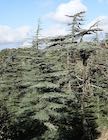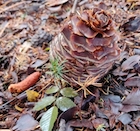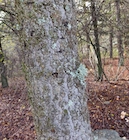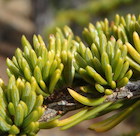
Native forest with Cedrus brevifolia in western Cyprus [Grzegorz Grzejszczak, 2020.03.19, Facebook post].

Another view of the native forest shown above [Grzegorz Grzejszczak, 2020.03.19, Facebook post].

A branch with mature seed cones, in the native forest shown above; iNaturalist observation 40507424 [Grzegorz Grzejszczak, 2020.03.19].

Foliage on a tree in a forestry plantation, Mount Parnis, Greece, elev. 1060m [Daniel Adam, 2020.10.29, Facebook post].

Dehiscent seed cone, two seedlings, and an old pollen cone; iNaturalist observation 36227661 [Davide Puddu, 2019.11.30].

Bark; iNaturalist observation 36227661 [Davide Puddu, 2019.11.30].

Leaf detail showing stomata; iNaturalist observation 18562817 [Daniel Cahen, 2018.11.22].

A fertile branch covered with pollen cones; iNaturalist observation 8666636 [whinaem, 2017.10.04].

Cedrus brevifolia
Elwes et Henry 1908
Common names
Cyprus cedar.
Taxonomic notes
Syn: Cedrus libani A. Rich. var. brevifolia Hook. f. 1880, Cedrus libani A. Rich. subsp. brevifolia (Hook. f.) Meikle 1977. All of the Mediterranean cedars are extremely similar in appearance and many authors have reduced them to varieties or, more properly (in view of their distinct ranges and climates), subspecies of C. libani, which was the first of these taxa to be described. I here treat C. brevifolia as a distinct species largely because of its widespread recognition in horticulture. One molecular study has shown it to be consistently distinct from the other cedars on the basis of molecular evidence, with a molecular clock indicating that C. libani and C. brevifolia have been distinct for about 5.3 to 10.5 million years (Qiao et al. 2007). Another study, using a new set of nuclear microsatellite markers, identified Lebanese C. libani as more similar to C. brevifolia than to Turkish C. libani (Karam et al. 2019), a result that argues for classifying C. brevifolia as a variety or subspecies of C. libani. C. brevifolia also has surprisingly high genetic diversity, possibly indicating relatively recent fragmentation of a formerly more extensive and uniform population, possibly during the Pleistocene/Holocene climate transition, or perhaps persisting even later until disrupted by human activity (Eliades et al. 2011).
Description
Trees to 20 m tall and 120 cm dbh, usually with a single columnar trunk and a pyramidal crown that becomes flattened and umbrella-shaped with age. Leaves on long shoots spirally arranged, radially spreading, more crowded at base of the long shoot; short shoots emerging in leaf axils, leaves densely crowded in false whorls of 20-35, most numerous on older short shoots, spreading radially, 5-16 mm long (may be longer at base of long shoots), 1-1.5 mm wide, narrowly linear, straight or curved, quadrangular, acute or acuminate, with some stomata on all surfaces; leaf color variably green and variably glaucous. Pollen cones terminal on short shoots, erect, subtended by leaves, numerous, 4-5 cm long, cylindrical, pale green ripening to pale brown. Seed cones terminal on short shoots, erect, sessile, woody in 2nd year, ovoid oblong or barrel shaped, with obtuse or indented apex, 8-12 × 3-6 cm, light green ripening to grey brown, dehiscent leaving a persistent conical rachis. Seed scales broad flabellate, thin, coriaceous, 3-3.5 cm long × 3.5-4 cm wide; glabrous with orange-brown pubescence at base; upper margin entire, slightly incurved. Seeds ovoid conical, 10-14 × 4-6 mm, brown; seed wings broad cuneate, 20-30 mm long (Farjon 2010). See García Esteban et al. (2004) for a detailed characterization of the wood anatomy.
Distribution and Ecology
Western Cyprus: Troodos Mountains, on silicate (igneous) substrates, where its distribution is limited to five sites. Sometimes occurs in pure stands, but often associated with Pinus brutia and Quercus alnifolia and in mixed forest with Platanus orientalis (Christou and Gardner 2011). Hardy to Zone 6 (cold hardiness limit between -23.2°C and -17.8°C) (Bannister and Neuner 2001).
Cedars of the Mediterranean; C. brevifolia in yellow. Distribution data from GBIF, 2021.02.17 and 2021.02.18.
When last assessed in 2010, this taxon remained "Vulnerable," as in prior assessments. At that time the area of occupancy was considerably less than 20 km2 and limited to one location. The population was increasing although some trees were showing signs of dieback that have been correlated with decreasing rainfall. This very restricted distribution makes it vulnerable to stochastic events despite protection measures that have been put in place. A continuing decrease in rainfall and an increase in the number of trees showing symptoms of dieback could quickly qualify this taxon as Critically Endangered (Christou and Gardner 2011).
Remarkable Specimens
I have seen no data for trees in habitat, and there are few measurements of ornamentals. Monumental Trees (2016) records that both the height and diameter records are held by a tree in Windsor Great Park, UK, measured in 2016 as 102 cm DBH and 30.50 m tall.
Ethnobotany
Observations
Remarks
The epithet refers to the unusually short needles, shorter than any other cedar species.
Citations
Christou, A. and M. Gardner. 2011. Cedrus libani var. brevifolia. The IUCN Red List of Threatened Species 2011: e.T34148A9844497. https://dx.doi.org/10.2305/IUCN.UK.2011-2.RLTS.T34148A9844497.en. Accessed 2021.02.17.
Eliades, N.-G. H., O. Gailing, L. Leinemann, B. Fady and R. Finkeldey. 2011. High genetic diversity and significant population structure in Cedrus brevifolia Henry, a narrow endemic Mediterranean tree from Cyprus. Plant Systematics and Evolution 294:185–198.
Elwes, H.J. and A. Henry. 1908. The trees of Great Britain and Ireland III. Edinburgh: Privately printed (p.467). Available: Biodiversity Heritage Library, accessed 2012.11.25.
Karam, Marie-Joe, Monique Aouad, Anne Roig, Audrey Bile, Magda Bou Dagher-Kharrat, Etienne K. Klein, Bruno Fady, and François Lefèvre. 2019. Characterizing the genetic diversity of Atlas cedar and phylogeny of Mediterranean Cedrus species with a new multiplex of 16 SSR markers. Tree Genetics & Genomes, https://doi.org/10.1007/s11295-019-1366-1.
Monumental Trees. 2016. Cyprus cedar in the area of Windsor Great Park. https://www.monumentaltrees.com/en/gbr/england/surrey/14721_windsorgreatpark/27806/, accessed 2017.09.04.
Qiao, C.-Y., J.-H. Ran, Y. Li, and X.-Q. Wang. 2007. Phylogeny and biogeography of Cedrus (Pinaceae) inferred from sequences of seven paternal chloroplast and maternal mitochondrial DNA regions. Annals of Botany 100:573–580.
See also
Elwes and Henry 1906-1913 at the Biodiversity Heritage Library. This series of volumes, privately printed, provides some of the most engaging descriptions of conifers ever published. Although they only treat species cultivated in the U.K. and Ireland, and the taxonomy is a bit dated, still these accounts are thorough, treating such topics as species description, range, varieties, exceptionally old or tall specimens, remarkable trees, and cultivation. Despite being over a century old, they are generally accurate, and are illustrated with some remarkable photographs and lithographs.
The species account at Threatened Conifers of the World.








